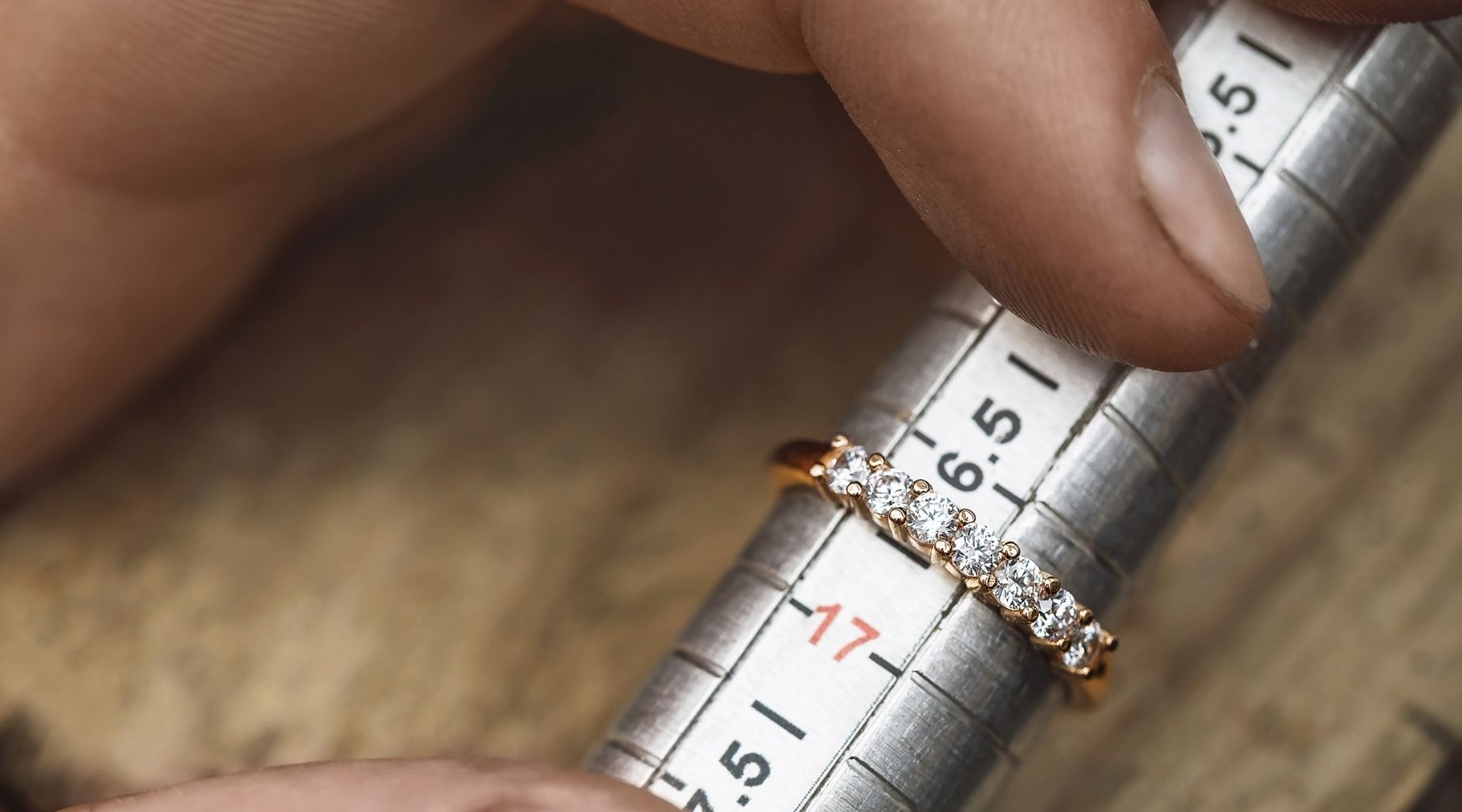So you’re looking for you or your partner’s ring size? At Northwood, we understand that most ring purchases are significant—whether this is due to sentimental value, cost, or other—, and the last thing we want is for you to get your ring only to learn that it doesn’t fit correctly. To make sure this doesn’t happen, we’re going to take the mystery out of this (sometimes daunting) task by giving you all the information you need to confidently determine your ring size.
Two Methods to Find Your Fit:
Things You Must Know:
When You Don't Know Your Partner's Size:
Visit a Jeweler
This may seem obvious, but the very best option is to get a professional’s help. Most jewelers offer a ring sizing service for free, and they will know what to look for to help you find the best fit.
What to Expect
There are a few questions that all jewelers will likely ask you when you visit them to get your ring size. Knowing what these are ahead of time so you can have your answers ready will help make your ring sizing experience as quick and simple as possible!
Comfort vs. Standard Fit
Will you be buying a comfort or standard fit ring?
There are two common ring styles: comfort and standard fit. There is sometimes the misconception that comfort fit rings and standard fit rings are different ring sizes, but this is not the case. They are simply different ring styles. This means that comfort and standard fit rings in the same size will have the same sized interior diameter.
At this point, you may be thinking, “So why does the style matter, then?”. In short, because different styles will feel and fit differently on your finger due to the shape of the interior circumference of the ring.
A standard fit ring is made with a flat interior circumference (shown, below). In this style, the total width of the ring will rest on your finger. This will make the ring feel more snug.
A comfort fit ring is made with an interior circumference shaped like a “D”. In this style, only a small portion of the total width of the ring rests on your finger. This will make the ring feel looser.
Ring Width
What is the width of the ring you will be purchasing?
The width of a ring will also impact how the ring fits and feels on your finger.
With a wider ring, a larger portion of your finger will be covered, and a larger portion of your finger must be pushed through the ring at once to put the ring on. Both of these things will make the ring feel more snug. Think of putting on a crew neck vs. a turtle neck shirt, both with the same sized neck opening. A turtle neck shirt is more difficult to put on, not because the opening is a different size, but because there is more material to go over your head; the same goes for a wider ring. It can feel more snug, not because it is a different size, but because there is more material to get onto your finger.
With a slimmer ring, the exact opposite will be true: a smaller portion of your finger will be covered, and a smaller portion of your finger must be pushed through the ring at once to put the ring on, both of which will make the ring feel more loose.
Below, watch our goldsmith put on the exact same ring in two different widths to see the difference in fit created by ring width.
So you know the style and width of the ring you want to be sized for: now what? Visit a jeweler and ask to be sized! When you visit the jeweler, they will likely use one or both of the tools below to determine your ring size.
Ring Sizer
The jeweler will typically choose a mid-point ring size, or a size that appears as though it may fit your finger, and will ask you to put the ring on to test its fit. Although most jewelers will guide you through this process, it may be useful to know that when you put the ring on, it is best to rest your finger on a surface. This ensures the remaining rings on the ring sizer aren’t weighing down the ring you are trying on, which could impact how the ring feels and fits on your finger.
Mandrel
If you visit the jeweler with a ring that comfortably fits you or your partner, they will be able to use this ring and a mandrel (see below) to determine your ring size in that style. Remember that ring style and width can impact the ring’s fit, so you will not want to bring a ring to the jeweler that is 6mm in width and a standard fit if you are shopping for a ring that is 3mm in width and a comfort fit.
Considerations for your Visit
If possible, it's helpful to visit two jewelers at different times of the day and ask to be sized for a ring in the same width and style as you plan on purchasing. For some, the changing weather and/or time of day can impact the fit of their rings, because our hands naturally swell and shrink over the course of a day and during different seasons. For instance, if you are trying to determine your ring size during the summer and you know that your hands are typically more swollen during this time, you may want to consider purchasing a ring that is slightly more snug*, to accommodate for the winter when your hands will be less swollen. This same logic applies if you are trying to determine your ring size during the winter, knowing that your hands will swell during the summer.
*A snug fit does not refer to a fit that is uncomfortably tight, or is very difficult to put on and remove from your finger. Your ideal ring size will fit comfortably during different seasons and times of the day.
Finding your Ring Size at Home
What does a Proper Fit Feel and Look Like?
Here are a few tips to make sure find your correct ring size:
- If the ring sizer isn’t fitting don’t force it.
- Find the fit that sits comfortably but not too tightly around the base of your finger (or the size that fits just snuggly over your knuckle).
The ring may still feel a bit loose at the base of the finger, but measuring at the widest point will help ensure that you can get the ring on and off comfortably.
- Make a fist and other natural movements with your hand while trying on the ring sizer.
- Size yourself for a ring at several different times: morning, evening, after exercise, etc.
Some find that the changing weather and/or time of day can impact the fit of their rings. Because our hands naturally swell and shrink over the course of a day, it is useful to check the fit in the late afternoon, and/or try on your ring sizer over the course of a few days, to accommodate these natural fluctuations.
- If possible, order a quarter size if you are between sizes.
Consider Ring Width and Style
The fit of each ring will feel slightly different depending on its width and style. To ensure you get the best fit possible, you should try to match the width and style of the ring sizer you are using to the width and style of the ring you intend to purchase. If you would like to know the “why” behind these considerations, we have explained it in the Comfort Fit vs. Standard Fit and Ring Width sections above.
At-Home Ring Sizing Methods
Keeping in mind what a proper fit feels and looks like, as well as ring width and style considerations, you’re ready to tackle sizing your ring finger at home.
Use Sizing Belt
A sizing belt works like a regular belt; push the end through the buckle, then slip the sizer onto your finger and adjust the belt until you achieve a comfortable fit. Once a comfortable fit is achieved, you can determine your size as indicated on the belt (typically by an arrow).
Use Tape & Ruler
Use Calipers

Ensure the unit of measurement on the calipers is set to millimeters, and the calipers read zero (0) when the sliding jaws are closed. Using the inside jaws (where the blades appear to be pointing away from one another; typically at the top of the calipers), place your ring over the jaws and roll the wheel on the calipers until the jaws are touching the interior circumference of the ring on both sides. Read the measurement displayed in millimeters on the calipers. This is the diameter of your ring, which will allow you to determine your ring size using a chart such as the following: https://www.stuller.com/articles/view/determining-ring-blank-lengths-in-b-and-s-gauge/.
DO NOT Use String
It's a common misconception that you can use string to measure your ring size. However, string will stretch when you wrap it around your finger, leading to an inaccurate measurement.
Finding your Partner’s Ring Size Secretly

If you’re reading this, you’re probably planning a proposal or a special gift. How exciting! We know that finding the right ring size for your partner without arousing suspicion can be tricky, so we’re going to try to make this as easy as possible for you.
One of the most reliable methods is to try to get your hands on a ring your partner currently wears and have it measured it at a jeweler’s. If you can get your hands on one of their rings, but you can’t make it to a jeweler’s without risking getting caught, you can also measure their ring size at home using calipers (see At-Home Ring Sizing Methods for more details).
If these options don’t work for you, reach out to us at sales@northwoodrings.com and we will give you some of our most carefully guarded tips & tricks!











